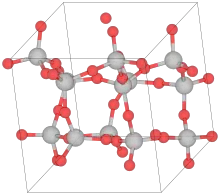| Keatite | |
|---|---|
 Crystal structure | |
| General | |
| Category | Silicate mineral |
| Formula (repeating unit) | SiO2 |
| Strunz classification | 4.DA.45 |
| Crystal system | Tetragonal |
| Identification | |
| Crystal habit | Microscopic inclusions |
Keatite is a silicate mineral with the chemical formula SiO2 (silicon dioxide) that was discovered in nature in 2013. It is a tetragonal polymorph of silica first known as a synthetic phase.[1] It was reported as minute inclusions within clinopyroxene (diopside) crystals in an ultra high pressure garnet pyroxenite body. The host rock is part of the Kokchetav Massif in Kazakhstan.[2]
Keatite was synthesized in 1954 and named for Paul P. Keat who discovered it while studying the role of soda in the crystallization of amorphous silica.[3] Keatite was well known before 1970 as evidenced in few studies from that era.[4][5]
References
- ↑ Ralph, Jolyon, and Ida Ralph. "Keatite: Keatite Mineral Information and Data." MinDat. 2013. Aug. 2013
- ↑ Abstract Hill, Tina R., Hiromi Konishi, and Huifang Xu, Natural occurrence of keatite precipitates in UHP clinopyroxene from the Kokchetav Massif: A TEM investigation, American Mineralogist, Volume 98, pages 187–196, 2013
- ↑ Science 120 (27 Aug1954) pp 328-330 with the title "A new crystalline silica.
- ↑ Li, C. T. (1971). "Transformation mechanism between high-quartz and keatite phases of LiAlSi2O6 composition". Acta Crystallographica Section B: Structural Crystallography and Crystal Chemistry. 27 (6): 1132–1140. doi:10.1107/S0567740871003649.
- ↑ Martin, Brigitte (December 1995). "Keatite; II, Hydrothermal synthesis from silica-glass". European Journal of Mineralogy. 7 (6): 1389–1397. Bibcode:1995EJMin...7.1389M. doi:10.1127/ejm/7/6/1389.
This article is issued from Wikipedia. The text is licensed under Creative Commons - Attribution - Sharealike. Additional terms may apply for the media files.